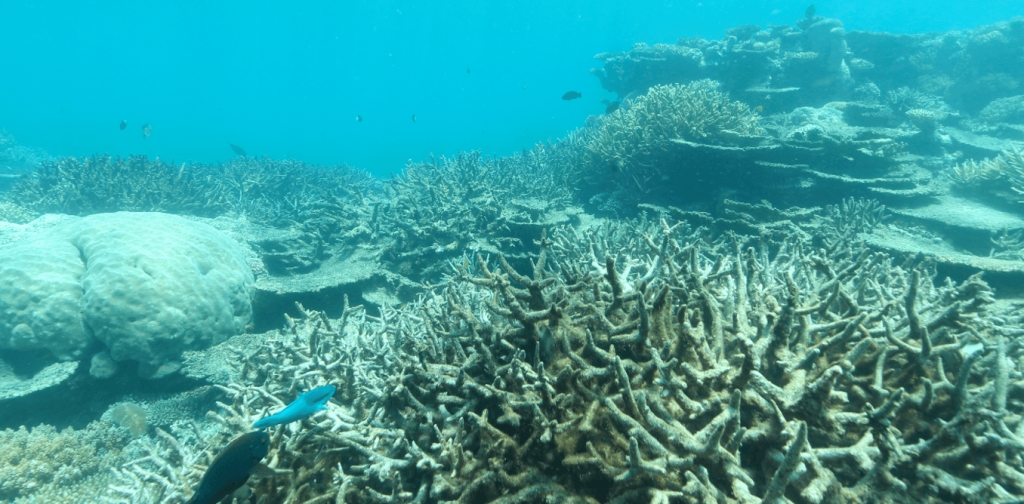Images of this year’s coral bleaching on the Great Barrier Reef shocked the world. Some tour operators expressed concern that the extensive and sometimes simplistic media coverage would hurt their businesses.
The reef was a hot-button issue during the federal election, with both major parties pledging funding for programs to enhance water quality. Some politicians and tour operators expressed optimism about the reef’s ability to recover.
It was the culmination of the longest, most extensive and most severe mass coral bleaching event ever recorded – an event that began in the North Pacific in mid-2014. The Great Barrier Reef was not spared, this year experiencing its hottest sea surface temperatures since records began – 29.1℃ in February (1.1℃ above the 1961-90 average), 29.1℃ (1.3℃ above average) in March and 27.8℃ (1.0℃ above average) in April.
Evidence of bleaching was found on 93% of the more than 900 individual reefs surveyed that month, with the most severe impacts on the most pristine and isolated reefs of the far north. A preliminary estimate is that 22% of coral has now died, with 85% of these deaths occurring between Cape York and just north of Lizard Island.
Map of the extent of coral bleaching observed on the Great Barrier Reef. GBRMPA/AIMS/Commonwealth Government/Queensland Government
At the height of the bleaching, the Climate Council’s chief executive, Amanda McKenzie, and councillor Tim Flannery visited a reef off Port Douglas that local tour operators have long regarded as one of the best – the quintessential underwater wonderland.
Amanda and Tim reported their shock and anger at what they saw – extensive areas of corals bleached brilliant white (see the Climate Council’s May 2016 report for a summary of the bleaching).
Several months later, the public’s shock and outrage has largely dissipated, but the question remains: are there signs that the reef’s hoped-for recovery is actually happening?
Reef revisited
This week, I joined Tim and Amanda in revisiting the site that had so dismayed them back in April. We were guided by the passionate conservationist John Rumney, who has been diving here for more than 40 years. John’s son-in-law Dean Miller was our videographer, above and below the water.
It was a beautiful day on the reef – calm and sunny. We noted that it was three years to the day since the incoming Abbott government sacked the Climate Commission – which in turn led to the establishment of the ongoing Climate Council.
Wet-suited, we slipped into the water and paddled towards the coral, our progress monitored by a drone buzzing overhead like some giant, demented mosquito.
So what did we find? Structurally, the reef appears intact, but the whole landscape is, well, subdued. While pockets of brilliant blue staghorn remain, much of the coral that bleached earlier this year is dead, the white skeletons filmed over by greenish-brown filamentous algae.
The fish community has also changed. Algae-eating species such as surgeon fish are doing well, but coral-feeders are hardly to be seen – I spotted only a single parrot fish in an hour of snorkelling. Meanwhile, the corals themselves seem to be showing symptoms of white spot and white band diseases, conditions associated with their diminished immune systems after the stress of bleaching.
The mood on the boat after the snorkelling was also subdued. The locals had not visited this particular reef since the height of the bleaching. Having now seen the extent of the coral death that has resulted, they fear this will eventually weaken the structural integrity of the reef, making it susceptible to future damage from storms.
This November’s spawning will hopefully reseed the reef, but our companions on the trip acknowledged that any repeated bleaching within the next few years will greatly reduce the chances of recovery.
As our boat pulled away from the reef, another took its place, full of tourists donning their snorkelling gear. I found myself hoping that most of them were first-timers – unencumbered by memories of the reef’s former glory.
Back in the real world, Australia’s greenhouse emissions continue to rise (by 1.1% in 2014-15) and the government’s current target of reducing emissions 26-28% below 2005 levels by 2030 is manifestly inadequate, even if achieved.
The continued burning of coal, oil and gas is estimated to have made the bleaching on the Great Barrier Reef this year at least 175 times more likely. At present rates of climate change, this level of bleaching could occur every two years by the 2030s. That would make recovery between events virtually impossible.
The forlorn, diminished state of Australia’s greatest natural treasure must continue to serve as a visible warning of what we stand to lose. The new normal is a very sad place to be.
 Lesley Hughes is affiliated with WWF-Australia (Board member and member of Eminent Scientist Advisory Group), Wentworth Group of Concerned Scientists, Climate Council of Australia
Lesley Hughes is affiliated with WWF-Australia (Board member and member of Eminent Scientist Advisory Group), Wentworth Group of Concerned Scientists, Climate Council of Australia
This article was originally published on The Conversation. Read the original article.




 How do halibut migrate? Clues are in their ear bones
How do halibut migrate? Clues are in their ear bones  Things that go buzz in the night – our global study found there really are more insects out after dark
Things that go buzz in the night – our global study found there really are more insects out after dark  Crocs love feral pigs and quolls have a taste for rabbit – but it doesn't solve the invasive species problem
Crocs love feral pigs and quolls have a taste for rabbit – but it doesn't solve the invasive species problem  ‘Legal animism’: when a river or even nature itself goes to court
‘Legal animism’: when a river or even nature itself goes to court  The big dry: forests and shrublands are dying in parched Western Australia
The big dry: forests and shrublands are dying in parched Western Australia  Climate change is warping the seasons
Climate change is warping the seasons  Why iconic trees are so important to us – and how replacing those that fall is often complicated
Why iconic trees are so important to us – and how replacing those that fall is often complicated  What if whales took us to court? A move to grant them legal personhood would include the right to sue
What if whales took us to court? A move to grant them legal personhood would include the right to sue  River deltas are threatened by more than climate change – leaving hundreds of millions of people at risk
River deltas are threatened by more than climate change – leaving hundreds of millions of people at risk  8 ways to tone down the Christmas lights to help wildlife – and why we should
8 ways to tone down the Christmas lights to help wildlife – and why we should  COP28 deal confirms what Australia already knows: coal is out of vogue and out of time
COP28 deal confirms what Australia already knows: coal is out of vogue and out of time  How agriculture can make the most of one of the world’s biggest carbon sink, soil
How agriculture can make the most of one of the world’s biggest carbon sink, soil 


































